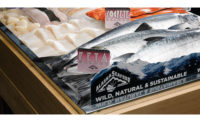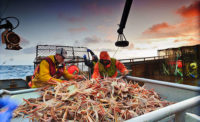Seafood consumption has seen a steady rise over the past five years, but the growth predicted in the next five may leave that in the dust. For many consumers, other proteins have often been a top choice at home, while seafood has been enjoyed at restaurants and on special occasions. As health and sustainability increasingly drive food choices, protein is king, good fats are celebrated and specialty diets such as paleo and ketogenic are common vernacular, consumers and retailers are becoming more familiar with various types of seafood, preparation methods and eating occasions. This October, which is National Seafood Month, may mark the start of an explosion in seafood consumption with a special emphasis on wild seafood.
According to Mintel in its Fish and Shellfish – US, November 2018 report, seafood consumption is up 13 percent over the last five years and is expected to continue to grow an additional 15 percent over the next five years. Growth in consumer shopping habits is driven primarily by the rise in interest in healthy, high-protein foods. According to Edelman Intelligence, 45 percent of consumers eat healthier than they did two years ago, and as a result, foodservice operators are providing more healthy options.
State of the Industry 2019
OverviewBeef (NCBA)
Pork
Chicken
Food Safety
Packaging
Beef (CAB)
Turkey
Veal
Lamb
Animal Welfare
Seafood
Workforce
Watch the 2019 State of the Industry Webinar
Register for free today!
As Americans develop this strong desire for a healthy lifestyle, seafood is positioned as an essential ingredient to maintaining a balanced diet. Seafood is low in saturated fats and high in omega-3 fatty acids, making it a high-quality, nutritious protein option with extensive health benefits to the heart, brain and gut. Wild seafood is low in contaminants and, if sourced from regions such as Alaska, protected from overfishing, adding the element of sustainability that consumers are increasingly seeking from the food they eat.
Consumers are willing to pay more for food produced sustainably or perceived to be of higher quality, according to The Power of Seafood. Product quality ranks highest among 10 factors for affecting the seafood purchase decision. As the supplier of nearly 60 percent of all wild seafood harvested in the U.S. (including nearly 95 percent of the wild salmon), Alaska’s cold, glacier-fed waters are leading the way as an unparalleled source for pure, high-quality seafood. In fact, according to a 2018 Technomic Report Seafood Consumer of the Future, seafood from Alaska “is inherently linked to positive attributes such as high quality, sustainable harvesting, and being a product of the U.S. As a result, consumers recognize Alaska seafood at a higher value.” Successful seafood brands continue to provide transparency with labels indicating seafood that is wild-caught, sustainable and responsibly sourced.
Despite its strong reputation as a healthy source of protein, people consume fish less often than other proteins. For consumers who don’t eat fish at all, taste and smell are barriers. The largest opportunity to increase seafood consumption lies with the people who occasionally eat seafood. For those consumers, perceived barriers are with convenience, versatility and affordability. With health as the primary purchase driver, suppliers should continue to leverage health messaging, especially in relation to more convenient forms of seafood, such as frozen, canned, shelf-stable and ready-to-eat varieties. According to Mintel, 25 percent of consumers think of frozen fish as nutritious compared with 51 percent with that perception of fresh fish. The reality is the nutritional profiles of frozen seafood are comparable if not potentially more nutritious than fresh as it is flash-frozen at sea at peak freshness.
The same Mintel study predicts the frozen segment to grow the fastest over the next five years, with frozen foods experiencing a revival as consumer perception shifts toward viewing frozen foods as equally nutritious to their fresh counterparts.
FROZEN SEAFOOD CATEGORY
| Subcategory | Dollar Sales | Dollar Sales % Chg YAgo | Unit Sales | Unit Sales % Chg YAgo |
| Frozen Fish/ Seafood | $2,332,778,454 | 3.3% | 292,777,329 | -1.2% |
| Frozen Shrimp | $2,679,552,685 | 6.0% | 298,647,485 | 6.7% |
| Total Frozen Seafood | $5,012,331,140 | 4.7% | 591,424,814 | 2.6% |
Source: IRI, a Chicago-based market research firm (@iriworldwide). Total US Multi-Outlet w/ C-Store (Grocery, Drug, Mass Market, Convenience, Military and Select Club & Dollar Retailers), latest 52 weeks ending Aug. 11, 2019. Note: Rankings of top brands are NOT totaled brand listings (e.g. all UPCs or brand extensions rolled up into a single figure, such as Total Crest Toothpaste), but are rather individual brand listings.
Younger adults are especially receptive to health and sustainability messaging, but are still getting their sea legs in seafood preparation and seeking guidance from brands on how to easily prepare seafood. According to data from The Power of Seafood, 84 percent of consumers are eager to learn more about how to prepare and cook seafood. With only a small percentage of consumers who consider themselves knowledgeable about cooking and buying fish, there is a large gap that presents the opportunity for retailers to address the emerging desire for guidance in seafood preparation.
The same Mintel study found seafood is tethered to dinner, special occasions or eating out at restaurants, while other protein sources are thought of across various meal occasions. Brands and retailers can expand versatility in messaging and offer inspiration to help consumers think of seafood more broadly as an option for various mealtimes. The rise of meal kits is already helping to increase familiarity with seafood preparation, though most meal kits are geared toward dinnertime. Snack offerings, including paired fish and cracker packages or jerky, are helping seafood to break out of the dinner category.
Despite the availability of a broad variety of species, consumers generally stick to salmon, shrimp and tuna. But foodservice operators are increasing menuing of lesser-known species, suggesting that there is growing interest in a wider variety of seafood options.
In addition to recognition of its many health benefits, seafood fits into various niche diets, including paleo, ketogenic and plant-based eating styles, such as the Mediterranean diet. While plant-based eating is on the rise, only 11 percent of consumers eat meat alternatives because they or someone in the household is vegetarian or vegan, according to Mintel. This suggests that seafood may still appeal to flexitarians, especially those attempting to eat less meat in favor of healthier, more environmentally friendly protein sources. Further, combining plants and seafood together as part of a regular diet improves absorption of essential nutrients and can fill in nutrient gaps such as EPA, DHA, Vitamin D and B12 that can be missing in exclusively plant-based diets. Plants and seafood work together to reduce the risk of developing chronic diseases.
REFRIGERATED FISH/ HERRING/ SEAFOOD:
TOP 10 RETAIL BRANDS
| Brand | Dollar Sales | Dollar Sales % Chg YAgo | Unit Sales | Unit Sales % Chg YAgo |
| Private Label | $118,784,027 | -19.9% | 20,192,297 | -5.1% |
| Trans Ocean | $66,324,755 | 6.5% | 25,206,073 | 5.6% |
| Acme | $29,597,968 | 8.4% | 3,285,283 | 5.6% |
| Echo Falls | $23,325,073 | -4.9% | 2,725,635 | -8.8% |
| Vita | $23,166,281 | -2.2% | 3,837,633 | -3.2% |
| Chicken of the Sea |
$19,825,649 | -5.1% | 1,085,529 | -7.1% |
| Dockside Classics | $17,474,623 | -11.8% | 2,872,395 | -8.1% |
| Paramount Reserve | $17,234,779 | -17.9% | 949,683 | -22.2% |
| Ducktrap River | $16,641,144 | 1.6% | 1,988,009 | 2.3% |
| Hilton | $15,507,410 | 11.9% | 2,054,802 | 4.5% |
| Total Category | $679,049,870 | -1.2% | 115,818,952 | 1.0% |
Source: IRI, a Chicago-based market research firm (@iriworldwide). Total US Multi-Outlet w/ C-Store (Grocery, Drug, Mass Market, Convenience, Military and Select Club & Dollar Retailers), latest 52 weeks ending Aug. 11, 2019. Note: Rankings of top brands are NOT totaled brand listings (e.g. all UPCs or brand extensions rolled up into a single figure, such as Total Crest Toothpaste), but are rather individual brand listings.
According to the 2018 Mintel report, fathers and men ages 18 to 54 are the two audiences that are most likely to buy fish and shellfish and have a strong desire for convenience. But with the recent updates to the U.S. Food and Drug Administration (FDA) recommendation, audiences such as pregnant women, mothers and young children who have traditionally been low seafood consumers because of health concerns, are now a segment poised for strong growth.
Despite the overall growth in seafood consumption, the average consumer in the U.S. still falls short of the FDA’s seafood intake recommendations of twice a week, especially among pregnant women. In July, the FDA recognized that pregnant and breastfeeding women were limiting their seafood intake because of a fear of mercury consumption. In order to provide more clarity, the FDA updated its guidelines with a new chart that outlines the best fish, good fish, and fish to avoid while pregnant.
Additionally, the FDA brought attention to the numerous health benefits of seafood, and that they far outweigh the chances of harm from trace amounts of mercury. Although all fish and shellfish contain tiny amounts of contaminants, Alaska fish and shellfish have among the lowest levels of all fish. Recent analyses from the state of Alaska confirm that Alaska pollock, salmon and cod present negligible health risks from mercury and other contaminants.
The seafood industry is on the upswing, with continued growth imminent in the coming years. A continued focus on the many health benefits, transparency of origin and additional attention to convenience factors, versatility and preparation will remain a priority over the next year as foodservice operators and retailers continue to encourage and support the growing levels of seafood consumption. NP




Report Abusive Comment